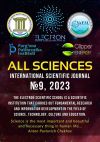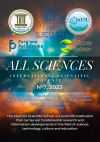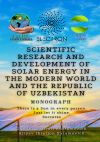Текст книги "All sciences. №2, 2023. International Scientific Journal"

Автор книги: Inom Yakubov
Жанр: Математика, Наука и Образование
Возрастные ограничения: +12
сообщить о неприемлемом содержимом
Текущая страница: 1 (всего у книги 3 страниц)
All sciences. №2, 2023
International Scientific Journal
Authors: Aliyev Ibratjon Xatamovich, Qo'ldashov Obbozjon Xokimovich, Yakubov Inom Daniyarovich, Yusupov Yarash, Vavilova Ekaterina Aleksandrovna, Abduraxmonov Sultonali Mukaramovich, Sayitov Shavkat Samiddinovich
Editor-in-Chief Ibratjon Xatamovich Aliyev
Illustrator Ibratjon Xatamovich Aliyev
Illustrator Obbzojon Xokimovich Qo'ldashov
Illustrator Sultonali Mukaramovich Abduraxmonov
Cover design Ibratjon Xatamovich Aliyev
Cover design Ra'noxon Mukaramovna Aliyeva
Scientific director Boxodir Xoshimovich Karimov
Economic Director Farruh Murodjonovich Sharofutdinov
Economic Consultant Botirali Rustamovich Jalolov
Proofreader Sultonali Mukaramovich Abduraxmonov
Proofreader Obbozjon Xokimovich Qo'ldashov
Proofreader Ekaterina Aleksandrovna Vavilova
© Ibratjon Xatamovich Aliyev, 2023
© Obbozjon Xokimovich Qo'ldashov, 2023
© Inom Daniyarovich Yakubov, 2023
© Yarash Yusupov, 2023
© Ekaterina Aleksandrovna Vavilova, 2023
© Sultonali Mukaramovich Abduraxmonov, 2023
© Shavkat Samiddinovich Sayitov, 2023
ISBN 978-5-0059-7572-0 (т. 2)
ISBN 978-5-0059-5900-3
Created with Ridero smart publishing system
PHYSICAL AND MATHEMATICAL SCIENCES
ABOUT THE USE OF THREE-DIMENSIONAL PRINTERS IN ARCHITECTURE
UDK 004.356.2
Aliev Ibratjon Khatamovich2nd year student of the Faculty of Mathematics and Computer Science of Fergana State University
Ferghana State University, Ferghana, Uzbekistan
Аннотация. Развитие современных технологий ведёт к совершенствованию большого вида привычных на сегодняшний день методов и способов сооружения зданий, но как известно всё более популярными являются методы использования трёхмерных принтеров для достижения этих целей. Подобная идея была активно разработана ранее, но для этого использовалась либо одна головка, либо несколько установок для одного здания, более того, такая технология не позволяла сооружать двух, трёх и т. д. этажные здания. Но кажется решение подобной проблемы было приведено на примере модели небольшого здания в одном из произведений.
Ключевые слова: архитектура, трёхмерные принтеры, технологии, строительства, методы, устройства.
Annotation. The development of modern technologies leads to the improvement of a large number of methods and methods of building construction that are familiar today, but as is known, methods of using three-dimensional printers to achieve these goals are becoming increasingly popular. A similar idea was actively developed earlier, but either one head or several installations for one building were used for this, moreover, such technology did not allow the construction of two, three, etc. storey buildings. But it seems that the solution to such a problem was given by the example of a model of a small building in one of the works.
Keywords: architecture, three-dimensional printers, technologies, construction, methods, devices.
Initially, it is worth pointing out that the structure model, namely one power plant, consists of 6 power generation units. They have 6 buildings for linear acceleration, 6 blocks for cyclotrons and also 6 blocks for power output, that is, in total, you need to create 18 buildings connected to each other. The hall of the linear accelerator itself, which is located at a depth of 12 meters, has a size of 10 meters in length and 4 meters in width, the height is about 3 meters. Directly above it, after 2 floors of the basement, the 1st floor begins and the same hall, but for the control panel of the linear accelerator.
In two directions from this hall there are offices with additional control or for administrative work. And behind them is a line of corridors. The width of the corridors is 2 meters, and for the rooms – 3. The second floor is identical, but is intended for technological equipment, that is, a laboratory is already located in the center so that in case of a malfunction, the necessary parts can be made. The cyclotron building is identical, but its hall is already 10 meters in size both in width and in length, as in the building for power generation.
If we find the total sum of the lengths of all walls for the linear accelerator, together with the basement at a depth of 12 meters, taking into account that the total number of rooms around is 11, then we get 190 meters for one floor, 1 meter thick, for radiation safety, and if take into account that the thickness of one coating is also 10 cm, you need to go this distance for a wall height of 3 meters, 30 times, that is, 5.7 km. As well as a floor with a total area of 280 m2. There are 5 such floors in total, for one building of the linear accelerator, and there are 6 buildings in total. Further, for the cyclotron, the same length will be 7.32 km with the same thickness, with an area of 400 m2 with the same number of 5 floors and 6 buildings, such the same alignment for the energy generation building.
Now it's worth imagining that we have a large mechanical arm that extrudes concrete, sets metal structures, and evenly pours all this coating. For floors, temporarily holding boards or strong metal sheets are installed, which can be removed after the concrete and cement have hardened. If you calculate, one such structure lays out a layer of cement 10 cm wide and moves at a speed of 12 meters per minute. Thus, for the floor of the linear accelerator, it will need to travel a distance of 28 km, taking into account the floor thickness of 1 m, for the walls, since their thickness is 1 meter, then it needs to travel 5.7 km, and in total 33.7 km for one floor or 168.5 km for one building.
All 6 buildings of the linear accelerator will be 1011 km, and the cyclotron 73.2 km for walls and 40 km for the floor, in total already 113.2 meters for a floor or 566 km for a building or 3396 km for all 6 cyclotron buildings or together with generating buildings 6792 km, and in total for this complex it will be necessary to pass 7803 km, on an area of 6480 m2. If we take into account the speed for one such robot, it will take 451 days and 13.5 hours of continuous operation of the printer.
Such a speed, of course, is not suitable, although it is very significant, unless it is proposed to increase the number of “hands”. This is what will be the solution. And for example, if you create a device with 50 such hands, then with one small building they will manage in 4 hours 40 minutes and 50 seconds, if there are already several such devices, say about 18, then you can manage for this time in total it will take about 17– 18 hours. It would take one person about two plus years to create a small plane for comparison, but if you bring in a large team and about 1,500 people, if not more, you can do it much faster. If one person created such a device according to ready-made instructions, then he would need about 2 months to assemble one device, for 50, respectively, 100 months.
These 100 months are more than 8 years, that is, to create such devices, you need to attract, respectively, 4 times more or 6,000 people to assemble per day, but if you start counting from 8:30 a.m., then you will have about an hour and a half to communication of plans to the general representatives of the project. Then, before 12 o'clock at night, it will be quite possible to gather the total number of people in such a way that before 6 o'clock in the morning on Wednesday, it would be possible to finish the building. It will take 17 hours to build, that is, the devices must be ready no later than Tuesday hour, that is, there will be 13 hours to assemble or half a day, which means that 12,000 people will have to be involved.
Truly epochal proportions, and this, not to mention those who will have to be administrators of these people, that is, in total about 13,200 people, if there is one leader for every ten.
And if you describe the result, you can come to the following picture.
In the fenced area, where, by the way, paths had already appeared, seedlings, trees were planted, a fence and other details were put up, at first there were 6 buildings of the linear accelerator connected to each other, therefore, they looked like one building 20 meters long and 84 meters wide, then 3 interconnected buildings were already built behind it, also 20 meters long, and when all 6 buildings in a row are completed, 120 meters wide and finally, another identical row with the same width and length. Behind him was the conference hall itself.
The entire hall inside had 4 floors connected to each other, while 2 of them were submerged underground, and 2 went upstairs. This hall was 90 meters wide and slightly smaller than the previous row of buildings, and 50 meters long. That is, it had an area of 4500 square meters, while if the stage occupied 1/8 of the total area or 562.5 square meters, then 3937.5 square meters remained, that is, 1968 people could already fit on the first floor, and almost as many on the subsequent floors, in total, 7875 people fit in this hall, which was simply stunning given the height of the hall of about 12 meters!
Both existing small printers were used to build this hall. With the same wall thickness of 1 m and a floor height of the same meter and a layer width of 10 cm, it was initially necessary to pass over an area of 450 km, while moving the structure. Further, for walls 50 meters long and as much as 20 meters high, 200 km are spent, and for walls 90 meters long, 360 km are spent, and 450 km for the roof. For floors with an area of 3937.5 square meters or with a width of 90 meters and a length of 43.75, it will be necessary to spend 393.75 km for one floor or 1181.25 km for 3 floors, for a total of 2641.25 kilometers.
As a result, it would take 15 hours 40 minutes and 30.27 seconds for one printer to create this hall, but since 2 such devices worked, the building was completed in 7 hours 50 minutes and 15.13 seconds.
So far the work has progressed at such a pace that the first model was ready at 5 o'clock in the morning, the second at 8 o'clock in the morning, then the large model was completed at 12 o'clock in the afternoon, and all the small buildings were already built at 10 o'clock in the afternoon, since 2 printers were working together . Then they began to create a conference room and by six o'clock in the evening they had completed. By that time, three large buildings had already been built and more were under construction. Then, by 3 pm, the second “cube” was ready, which started work when the first one completed 3 buildings, as already mentioned, and together with it by 5 pm they completed all 6 large buildings for cyclotrons.
Now there were 6 more of the same buildings for energy generation, and then there were small works. Furnishing, repair, decoration of the previous buildings were in full swing. In a record 2 hours, the third large printer was already ready, which, together with the existing two, was able to complete the remaining 6 buildings in 2 hours. Therefore, by 7 pm, the entire building with 18 blocks and halls was completely ready, and only work on decorating the inside continued.
The roofs were also already covered, and thanks to the creation of only 5 printers instead of 18, the count was able to save a little less than half of the originally named budget, for the construction of all equipment and buildings, respectively. Finally, the case was completed with a huge gain of 11 hours from the named time. They wanted to finish the construction at 6 am on May 11, but it turned out that they had already finished at 7 pm on May 10, it was a victory!
And just a titanic work was done, epoch-making!
The purpose of this description was to convey the basic idea that everything is possible, even such an amazing task as building an entire power plant in less than 2 days, albeit with the involvement of a huge amount of a wide variety of resources, as well as using the latest 3D building printing technology, with a stop at the stage of completing the printing of the first floor and the installation of the structure, on top of which the printing of the next floor will continue in parallel.
References1. Architectural structures. In 3 books. Book 1. Architectural designs of low-rise residential buildings; Architecture-S – Moscow, 2006. – 248 p.
2. Bayer V. E. Architectural materials science; Architecture-S – Moscow, 2006. – 264 p.
3. Belokonev E. N., Abukhanov A. Z., Belokoneva T. M., Chistyakov A. A. Fundamentals of architecture of buildings and structures; Phoenix – Moscow, 2009. – 336 p.
4. Boitemirov F. A., Golovina V. M., Ulitskaya E. M. Calculation of structures made of wood and plastic; Academy – Moscow, 2007. – 160 p.
5. Giyasov Adkham Planar and spatial structures of building coverings; Publishing House of the Association of Construction Universities – Moscow, 2008. – 144 p.
6. Grebennik R. A., Grebennik V. R. Installation of steel and reinforced concrete building structures; Academy – Moscow, 2009. – 288 p.
7. I. V. Grigoriev, V. I. Prokop’ev, and Yu. V. Tverdy, Deformation, Stability, and Vibrations of Shell Structures; Publishing House of the Association of Construction Universities – Moscow, 2007. – 208 p.
8. Devyataeva GV Technology of reconstruction and modernization of buildings. Tutorial; Infra-M -, 2003. – 256 p.
9. Iodo I. A., Potaev G. A. Urban planning and territorial planning; Phoenix – Moscow, 2008. – 288 p.
10. Kashkina L. V. Fundamentals of urban planning; Vlados – Moscow, 2005. – 248 p.
11. Mailyan L. R., Lazarev A. G., Seferov G. G., Batienkov V. T. Structures of buildings and structures with static elements; Infra-M -, 2010. – 688 p.
12. Mailyan R. L., Mailyan D. R., Veselev Yu. A. Building structures; Phoenix – Moscow, 2010. – 880 p.
13. Maklakova T. G. Architectural and constructive design of buildings. Volume 1. Residential buildings; Architecture-S – Moscow, 2010. – 328 p.
14. Mironov V. V., Mironov D. V., Chikishev V. M., Shapoval A. F. Use of soft geosynthetic shell structures in construction; Publishing House of the Association of Construction Universities – Moscow, 2005. – 573 p.
15. Mityugov E. A. Course of metal structures; Publishing House of the Association of Construction Universities – Moscow, 2008. – 120 p.
16. Nikulin A. D., Shmitko E. I., Zuev B. M. Design of enterprises of building materials, products and structures; Prospect Nauki – Moscow, 2006. – 352 p.
17. Ponamarev A. B. Reconstruction of the underground space; Publishing House of the Association of Construction Universities – Moscow, 2006. – 232 p.
USING PHOTON TUNNELING TECHNOLOGY FOR DIRECT TELEPORTATION
Aliev Ibratjon Khatamovich2nd year student of the Faculty of Mathematics and Informatics, Fergana State University
Fergana State University, Fergana, Uzbekistan
Аннотация. В работе описан метод, являющийся аналогом квантовой телепортации при перемещении определённых объектов с указанием некоторых парадоксом. При этом большое внимание уделяется общему представлению процесса, а также приводятся математические закономерности. Данный метод также является своего рода решением вопроса этической проблемы классической квантовой телепортации.
Ключевые слова: фотонное туннелирование, телепортация, переход, ядерные реакции, запутанные частицы.
Annotation. The paper describes a method that is analogous to quantum teleportation when moving certain objects with the indication of some paradoxes. At the same time, much attention is paid to the general representation of the process, and mathematical patterns are also given. This method is also a kind of solution to the ethical problem of classical quantum teleportation.
Keywords: photon tunneling, teleportation, transition, nuclear reactions, entangled particles.
Today, the phenomenon of quantum teleportation is actively known, which makes it possible to entangle two certain particles, linking their spins to each other, while most often two photons or electrons can be connected. To bind photons, the most commonly used is the passage of a laser beam (with more uniform characteristics) and, if necessary, which is more likely to interfere through a nonlinear crystal with separation into two additional beams. The most common are barium beta-borate, lithium triborate, potassium titanyl phosphate, potassium niobate, or the more commonly used L-arginine maleine dihydrate or 2-L-methionyl maleine dihydrate.
Two electrons can also be entangled in a similar way, but the problem was that upon contact of such particles with others with a subsequent change in their spin, the second entangled particle, located at an arbitrarily large distance, turned into an exact copy of the given particle, when it collapsed fully. But here the question initially arises of delivering the second particle – a photon or electron to the place where the object itself needs to be sent, and this in itself causes both inconvenience and too much time wasting to move at least to other exoplanets located at a distance no less than tens of light years.
Moreover, the very assertion of the destruction of the original object leads to a kind of strange feeling about the ethics of this kind of experiment, since when using macro objects or biological organisms, the original being is simply destroyed and its copy remains. A companion, rather than a substitute for such an idea, is a new theory of photon tunneling based on the following idea.
Any part in any system has a precise defined energy that can be transferred in the form of a wave, in particular in the form of a photon or gamma ray, and also in the form of a particle with high energy. For this example, deuterons will be used, into which all particles of the body will be generated according to (1), when bombarded by a stream of electrons with certain energies.

But it is worth considering that in this case, the electron energy was selected resonantly, that is, in such a way as to increase the probability of a given reaction channel in relation to others up to 96—97%, as happens in energy resonant nuclear reactions with increased monochromaticity. And since there are no more than 1-5 particles with almost identical energy in the body, then in 4.85 cases out of 5 particles, they will be converted into such deuteron-neutron pairs correctly, and the remaining parts can be turned into the most probabilistic channel, forming other more massive particles, most often nuclei, by the energies of which it is easy to understand which of the pairs they belong to.
Further, due to their charge, deuterons are removed from the chamber, and neutrons, with residual nuclei, are additionally irradiated by protons, while equation (2) applies for nuclei, and (3) for neutrons.


The energy of proton beams is also selected resonantly. And all electron shells for all irradiated nuclei under the influence of an electric field with an accurate calculation of energy changes when they meet with a parasitic electric field of electromagnets (when rotated by magnetic fields) are calculated separately. Further, the neutrons remaining after this are additionally bombarded by protons according to (3). As a result, the body is divided into 3 layers of deuteron flows with their own pairs and identical energies, each of which is selected and calculated separately. Thus, there are three groups of particles – deuterons and electrons, into which the organism has turned, and electrons, according to the energy of which it is possible to write down the energy in the form of information for each deuteron-electron particle of the organism.
Next, we can consider the probability of tunneling of such a particle (4).

From this relation, it turns out that for the tunneling of an object, the kinetic energy of the particle itself must be equal to the value of the potential barrier, which led to the highest probability of 80%. In the case of a different difference, that is, when the energy of the particle is less than the potential barrier, the probability begins to fall rapidly, when in the opposite case it increases.
The above arguments are, in essence, direct evidence that it is enough to give and choose the correct vector for all three groups of deuterons-electrons of the body using one or another accelerator, in which it is necessary to maintain the highest possible high vacuum, as the fluctuations will increase many times and this will lead to the disappearance of all particles at one point and the transition to a certain point in the universe, depending on the size of the barrier – the length of the path and direction – the vector of the radiation itself.
Thus, it is possible to present the latest technology of teleportation of any object, without its preliminary destruction, in terms of the use of quantum tunneling at the moment, or its transition through the space of photon fluctuations, if we consider this kind of teleportation type.









































